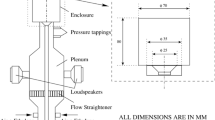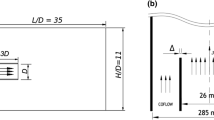Abstract
Subgrid-models for Large Eddy Simulation (LES) of compressible turbulent flow are tested for the three-dimensional mixing layer. For the turbulent stress tensor the recently developed dynamic mixed model yields reasonable results.A priori estimates of the subgrid-terms in the filtered energy equation show that the usually neglected pressure-dilatation and turbulent dissipation rate are as large as the commonly retained pressure-velocity subgrid-term. Models for all these terms are proposed: a similarity model for the pressure-dilatation, similarity andk-dependent models for the turbulent dissipation rate and a dynamic mixed model for the pressure-velocity subgrid-term. Actual LES demonstrates that for a low Mach number all subgrid-terms in the energy equation can be neglected, while for a moderate Mach number the effect of the modelled turbulent dissipation rate is larger than the combined effect of the other modelled subgrid-terms in the filtered energy equation.
Similar content being viewed by others
References
Rogallo, R.S. and Moin, P., Numerical simulation of turbulent flows.Ann. Rev. Fluid Mech. 16 (1984) 99–137.
Germano, M., Turbulence: the filtering approach.J. Fluid Mech. 238 (1992) 325–336.
Bardina, J., Ferziger, J.H. and Reynolds, W.C., Improved turbulence models based on LES of homogeneous incompressible turbulent flows. Department of Mechanical Engineering, Report No. TF-19, Stanford (1984).
Zang, Y., Street, R.L. and Koseff, J.R., A dynamic mixed subgrid-scale model and its application to turbulent recirculating flows.Phys. Fluids A 5 (1993) 3186–3196.
Yoshizawa, Y., Statistical theory for compressible turbulent shear flows, with the application to subgrid modelling.Phys. Fluids 29 (1986) 2152–2164.
Erlebacher, G., Hussaini, M.Y., Speziale, C.G. and Zang, T.A., Toward the Large-Eddy Simulation of compressible turbulent flows.J. Fluid Mech. 238 (1992) 155–185.
Moin, P., Squires, K., Cabot, W. and Lee, S., A dynamic subgrid-scale model for compressible turbulence and scalar transport.Phys. Fluids A 3 (1991) 2746–2757.
El-Hady, N.M., Zang, T.A. and Piomelli, U., Dynamic subgrid-scale modelling for high-speed transitional boundary layers.ASME Fed-Vol. 162 (1993) 103–112.
Blaisdell, G.A., Mansour, N.N. and Reynolds, W.C., Compressibility effects on the growth and structure of homogeneous turbulent shear flow.J. Fluid Mech. 256 (1993) 443–485.
Zeman, O., On the decay of compressible isotropic turbulence.Phys. Fluids A 3 (1991) 951–955.
Sarkar, S., Erlebacher, G., Hussaini, M.Y. and Kreiss, H.O., The analysis and modelling of dilatational terms in compressible turbulence.J. Fluid Mech. 227 (1991) 473–493.
Geurts, B., Vreman, B., Kuerten, H. and Theofilis, V., LES modelling errors in free and wall-bounded compressible shear layers. In: Rodi, W. and Martelli, F. (eds),Engineering Turbulence Modelling and Experiments 2. Amsterdam: Elsevier (1993) pp. 325–334.
Meneveau, C., Statistics of turbulence subgrid-scale stresses: Necessary conditions and experimental tests.Phys. Fluids 6 (1994) 815–833.
Reynolds, W.C., The potential and limitations of direct and large eddy simulations. In: Lumley, J.L. (ed.),Whither Turbulence? Turbulence at Crossroads. Berlin: Springer-Verlag (1990) p. 313.
Ragab, S.A. and Wu, J.L., Linear instabilities in two-dimensional compressible mixing layers.Phys. Fluids A 1 (1989) 957–966.
Sandham, N.D. and Reynolds, W.C., Three-dimensional simulations of large eddies in the compressible mixing layer.J. Fluid Mech. 224 (1991) 133–158.
Comte, P., Lesieur, M. and Lamballais, E., Large and small-scale stirring of vorticity and a passive scalar in a 3D temporal mixing layer.Phys. Fluids A 4 (1992) 2761–2778.
Kuerten, J.G.M., Numerical definition document for the ISNaS time-explicit flow solver. Memorandum No. 934, University of Twente (1991).
Moser, R.D. and Rogers, M., The three-dimensional evolution of a plane mixing layer: Pairing and transition to turbulence.J. Fluid Mech. 247 (1993) 275–320.
Liu, S., Meneveau, C. and Katz, J., Experimental study of similarity subgrid-scale models of turbulence in the far-field of a jet. In: Voke, P.R., Kleiser, L. and Chollet, J.P. (eds),Direct and Large-Eddy Simulation I. Dordrecht: Kluwer Academic Publishers (1994) pp. 37–48.
Schumann, U., Modelling of Reynolds-stress turbulence models.Phys. Fluids 20 (1977) 721–725.
Vreman, B., Geurts, B. and Kuerten, H., Realizability conditions for the turbulent stress tensor in large-eddy simulation.J. Fluid Mech. 278 (1994) 351–362.
Vreman, B., Geurts, B. and Kuerten, H., On the formulation of the dynamic mixed subgrid-scale model.Phys. Fluids 6 (1994) 4057–4059.
Wong, V.C., A proposed statistical-dynamic closure method for the linear or nonlinear subgrid-scale stresses.Phys. Fluids A 4 (1992) 1080–1082.
Author information
Authors and Affiliations
Rights and permissions
About this article
Cite this article
Vreman, B., Geurts, B. & Kuerten, H. Subgrid-modelling in LES of compressible flow. Appl. Sci. Res. 54, 191–203 (1995). https://doi.org/10.1007/BF00849116
Received:
Accepted:
Issue Date:
DOI: https://doi.org/10.1007/BF00849116




